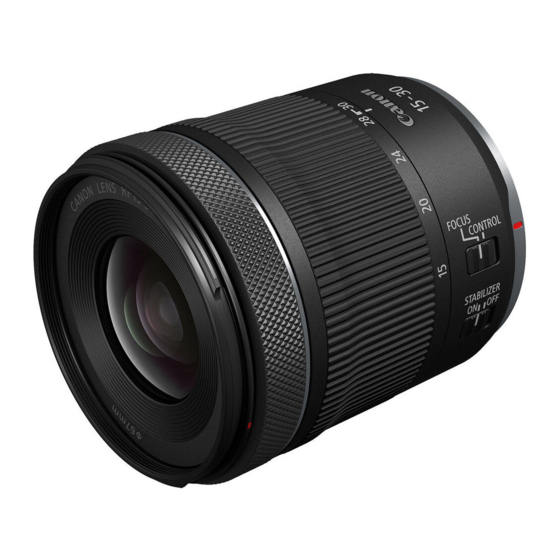
Table of Contents
Advertisement
Quick Links
Advertisement
Table of Contents

Summary of Contents for Canon RF15-30mm F4.5-6.3 IS STM
- Page 1 Instructions...
- Page 2 Thank you for purchasing a Canon product. Canon RF15-30mm F4.5-6.3 IS STM is a ultra- Camera Firmware and Camera wide zoom lens for use with EOS R series Applications cameras. Please use the latest versions of firmware and “IS” stands for Image Stabilizer.
-
Page 3: Safety Precautions
Safety Precautions Precautions to ensure that the camera is used safely. Read these precautions thoroughly. Make sure all details are observed in order to prevent risks and injury to the user and other people. Details pertaining to risks that Warning may result in death or serious injury. -
Page 4: General Precautions
General Precautions Handling Precautions Do not leave the product in excessive heat such as in a car in direct sunlight. High temperatures can cause the product to malfunction. If the lens is taken from a cold environment into a warm one, condensation may develop on the lens surface and internal parts. - Page 5 This device complies with Part 15 of the FCC Rules. CAN ICES-3 (B) / NMB-3 (B) Operation is subject to the following two conditions: (1) This device may not cause harmful interference, and (2) this device must accept any interference received, including interference that may cause undesired operation.
- Page 6 Nomenclature Focusing/ Focusing/control selector switch (→ 7) Control ring (→ 7) Hood mount (→ 15) Zoom position index (→ 12) Filter mounting thread (→ 16) Zoom ring (→ 12) Contacts (→ 6) Image stabilizer switch (→ 13) Lens mount index (→ 6) Lens mount (→...
-
Page 7: Attaching And Detaching The Lens
1. Attaching and Detaching the Lens Lens mount index Set the camera’s power switch to OFF when attaching or detaching the lens. Attach the lens cap before detaching the lens from the camera. After detaching the lens, place the lens with the rear end up and attach the dust cap to prevent the lens surface and contacts from getting scratched. - Page 8 2. Focusing/control ring The focusing/control ring can be used as either a This lens does not have a focus mode switch. focusing ring or a control ring. Delayed focus may occur if the focusing ring (focusing/control ring) is quickly turned. Focusing/control ring When the AF does not operate after switching the focus mode from [MF] to [AF] and when the...
- Page 9 Focusing/control ring Use as a Control Ring The lens’ focusing ring (focusing/control ring) is electronic. Set the focusing/control selector switch to With a camera capable of electronic full-time CONTROL. Set the control ring function using manual focus, manual focusing is possible the camera’s menu.
- Page 10 3. Taking Closeup Shots in the Manual Focusing (MF) Mode When using this lens, shots taken with the Wide-end Examples: camera’s manual focusing (MF) mode within a range of less than 20 mm from the wide end make the subject seem closer and larger than with the autofocus (AF) mode.
- Page 11 Taking Closeup Shots in the Manual Focusing (MF) Mode Take the following steps for shooting in the [MF-only range]. Set the focusing/control selector switch to FOCUS. Set the focusing mode on the camera to [MF]. Set the focal length to a wider setting than 20mm with the zoom ring. Turn the focusing ring in the short-range direction to move the focusing position from [AF in-focus range] to [MF-only range].
- Page 12 Taking Closeup Shots in the Manual Focusing (MF) Mode It is possible to check the focusing position with the use of the camera’s focusing distance display function* Wide-angle focusing distance display (image) Camera monitor display (image) ③ ④ ① ② Telephoto focusing distance display (image) ②...
- Page 13 4. Zooming To zoom, turn the lens' zoom ring. Be sure to finish zooming before focusing. Zooming after focusing can affect the focus. Blurring may temporarily occur if the zoom ring is quickly turned. Please be careful not to let your fingers get caught in between the lens' front and the focusing/ control ring when zooming.
-
Page 14: Image Stabilizer
5. Image Stabilizer The Image Stabilizer cannot compensate for a blurred shot caused by a subject that moved. The Image Stabilizer may not be fully effective if you shoot from a violently shaking vehicle or other transportation. When using a tripod, it is recommended that you set the Image Stabilizer to OFF. - Page 15 Image Stabilizer The Image Stabilizer for this lens is suited to hand-held shots in the following conditions. In semi-darkened areas such as indoors or outdoors at night. In locations where the flash cannot be used, such as art museums and theater stages. In situations where your footing is uncertain.
- Page 16 6. Hood (Sold separately) The custom lens hood reduces unwanted light that causes flare and ghosting and protects the front of the lens from rain, snow, and dust. Attachment position mark Red dot Detaching the Hood Red dot Red dot Attachment position mark Stop position mark Rotate the hood in the direction of the arrow until...
- Page 17 7. Filters (Sold separately) You can attach filters to the filter (Φ67) mounting thread on the front of the lens. Only one filter may be attached. ENG-16...
-
Page 18: Specifications
Specifications Focal Length/Aperture 15-30mm f/4.5-6.3 Lens Construction 11 groups, 13 elements Maximum Aperture f/4.5-6.3 (1/3 stops), f/4.5-6.7 (1/2 stops) Minimum Aperture f/22-32 Angle of View Horizontal: 100°25'-61°55', Vertical: 77°20'-43°35', Diagonal: 110°30'-71°35' AF Mode Focal Length 15 mm 20 mm 24 mm 30 mm Min. - Page 19 There are cases in which using the zoom function during continuous shooting may result in conspicuous image distortion. All data listed is measured according to Canon standards. Photos shown are for illustration purposes only. Product specifications and appearance are subject to change without notice.
- Page 20 CT1-D249-A 0522Ni © CANON INC. 2022...









